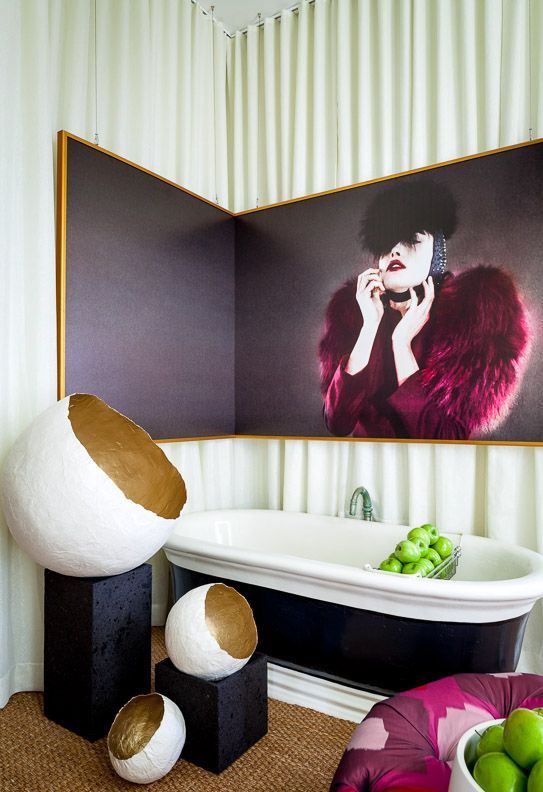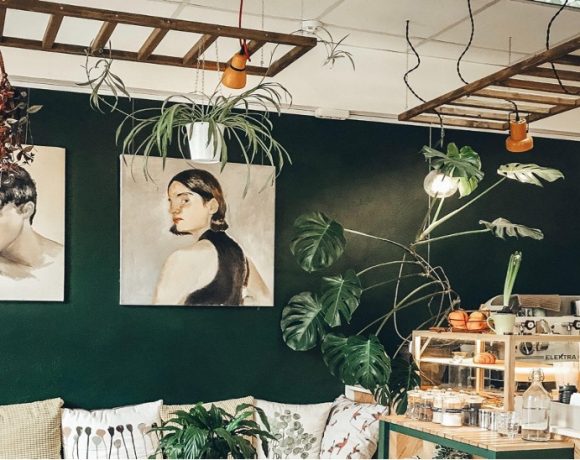Boston-based interior designer Stephanie Rossi talks about how she fulfills her clients’ needs for art with the perfect art pieces.
by Megan Kaplon
Stephanie Rossi, the owner of Boston’s Spazio Rosso design company and one of Boston Common magazine’s Top 10 Interior Designers to Know, once tried to convince herself that her passion, art, could never be her job. After completing business school and helping her husband, a chef, design a restaurant, however, she realized her reluctance was futile. She enrolled in an interior-design program at Suffolk University in Boston and shortly thereafter burst onto the city’s design scene and onto the pages of Boston Globe Magazine, Boston magazine, Design New England and New England Home.
We tracked her down to find out how an interior designer determines what art pieces will fit her clients’ taste and lifestyle, which Boston galleries are her favorites, and what artists made the cut to hang on her own walls at home.
Art Business News: How did you first become interested in design?
Stephanie Rossi: I’ve always had a fine-arts background and been involved in classes and extracurricular activities surrounding art, but I didn’t want something that I really enjoyed as a hobby to become a pressure-filled career decision. After business school, I met my husband, who is a chef, and he was about to open a restaurant at a winery and needed help with the decor and the layout for the restaurant. It sort of hit me then that interior design was a good way for me to involve all the things that I like about art and learning about it and spatial relationships and color and fabrics and shape and size into one thing that I could tangibly call a profession.
ABN: How has business school helped in your interior design career?
SR: I think that probably it’s helped more than my fine-arts background in dealing with people and the psychology of working with individuals on such a familiar, sensitive subject. You’re in people’s homes talking to them about the way they live, but you’re also running a business. There’s a fine line of how to marry those things together.
ABN: Do you do a lot of art buying for people?
SR: It’s sort of a split. Some of my clients have their own collection that we have to incorporate, but a lot of them, because they’re younger, are interested in being educated on it, so we go through the process of learning about different galleries and different artists to find what they like and what fits their budget.
ABN: Do you think it’s more challenging to design with nothing or with a full collection of artwork?
SR: I love designing from scratch. I mean, who wouldn’t? I think every designer’s dream is to have a blank slate. But I do like the challenge of when a client comes to me and says, “I have a few pieces that we obviously need to incorporate.” That’s a really fantastic challenge for any designer to have.
ABN: What’s the process of figuring out what art will fit a client’s style?
SR: You can get a sense of someone’s level of experience [with art] the minute you go into their home or see the Pinterest pictures of things they like. Once you get a sense of where they’re at, you don’t want to overwhelm or intimidate them by showing them certain artists. So, in the beginning, I’ll direct them to local galleries that showcase multiple artists and sculptors, and we’ll go visit them if they have openings and develop an idea of what the client’s comfort level is. You can get a visceral sense immediately when someone looks at something. They might not verbally tell you, but you can tell their reaction physically to [an artist]. It’s a sensitive topic because nobody wants to immediately say, “Oh no, I don’t like that.” It’s like wine. Everybody gets very intimidated about wine tasting. It’s the psychology of it. You want to direct the client to a particular gallery or group of artists where you can push the limits a little bit, but not too far.
ABN: Are there certain questions you ask your clients to try to figure out what their style is?
SR: I submit to them an icebreaking exercise, a series of questions that are completely unrelated to their creative tastes, just about how they live and think. For example, I think it’s very important to find out what they’re reading: what sort of books you like to read or magazines do you subscribe to, or how do you get your mail? Those are things on a psychological level that show how their brains work. Are they left-brained or right-brained? Are they more literal? Are they analytical? Another thing that I ask is: Do you gravitate toward the floor? Some clients don’t know what I mean by that. It’s like, if you’re sitting or you’re having a meeting with someone or you’re watching television, do you sit on the floor when you do that, or are you always sitting at a table or a desk or a chair? Those are little things that they don’t realize are important, but it gives me a sense [of whether] they’re more casual or more structured.
ABN: What’s your relationship to artists and galleries? Are there a few you work with frequently?
SR: I really like Jules Place; she’s in SoWa [South of Washington (Street), a nonprofit association of professional studio artists in Boston]. She has a few open houses that you can bring clients to. I’ve brought a couple of my clients to First Fridays [where artists open their studios to showcase their work], and that’s a great way of showing them the galleries, including Adelson Galleries, along Harrison Avenue. There’s no commitment to it. Everybody can look and ask questions, and it’s not like you’re going to see a specific artist and risk your client’s not liking them. There’s also a gallery in Lincoln, Mass., the Clark Gallery, that I really like. They represent Lynette Shaw, who is a very well-known local artist. There are just so many amazing artists in the area.
ABN: What makes a gallery attractive to an interior designer?
SR: It depends on what I’m looking for. Jules Place is very approachable, and she has a lot that you can see there. Clark Gallery is more of a museum setting, which I really like. To some people, that’s a little more intimidating, but I like viewing fewer artists on the big white walls and seeing installations.
ABN: What kind of art do you have in your home?
SR: I actually have a Lynette Shaw, which I am happy to say that I own. I also have photography from a [Polish] photographer that I worked with on a project for the Junior League, and her name is Paulina Otylie Surys. She currently lives in London, and she shoots for Vogue and a bunch of other designers and clients, but she also does her own photography, and she uses these amazing techniques and printing qualities in her work. She was kind enough to grant me the right to two of her photographs, and I got them printed up enormously for the Junior League project, [and now they’re] hanging in my house, along with art by Michael Anastassiades and Helen Meyerowitz.
ABN: How do you think art and design trends relate to each other?
SR: I see there’s a shift in interior-design trends, almost like everything is OK; there’s not a set style anymore. There’s not just the traditional or the conservative or the modern. There’s this big eclectic mix that’s running through interior design right now because people are more aware of what’s out there and what’s accessible to them.
ABN: Does that trend open up the market to more nontraditional artists?
SR: I think so, yes, and I also think it gives people reflection. For example, portraits, which are obviously considered very classical, traditional art, are popping up in incredibly modern and contemporary interiors.
For more about Stephanie Rossi’s work, check out spaziorosso.com.










NO COMMENT